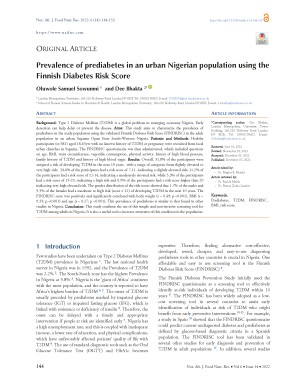Prevalence of prediabetes in an urban Nigerian population using the Finnish Diabetes Risk Score.
Abstract
Background: Type 2 Diabetes Mellitus (T2DM) is a global problem in the emerging economy of Nigeria. Early detection can help delay or prevent the disease. Aims: This study aims to characterize the prevalence of prediabetes in the study population using the validated Finnish Diabetes Risk Score (FINDRISC) in the adult population in an urban Sagamu Ogun State South-Western Nigeria. Patients and Methods: Healthy participants (n = 581) aged 18-65 years with no known history of T2DM, hypertension, or pregnancy were recruited from local urban churches in Sagamu. The FINDRISC questionnaire was then administered, which included questions on age, BMI, waist circumference, vegetable consumption, physical activity, history of high blood pressure, family history of T2DM, and history of high blood sugar. Results: Overall, 51.8% of the participants were assigned a risk of developing T2DM in the next 10 years, with a range of categories from slightly elevated to very high risk; 34.4% of the participants had a risk score of 7-11, indicating a slightly elevated risk; 11.2% of the participants had a risk score of 12-14, indicating a moderately elevated risk, while 5.3% of the participants had a risk score of 15-20, indicating a high risk and 0.9% of the participants had a risk score higher than 20 indicating very high elevated risk. The gender distribution of the risk scores showed that 1.7% of the males and 9.5% of the females had a moderate to high risk (score ≥ 12) of developing T2DM in the next 10 years. The FINDRISC score was positively and significantly correlated with weight (r = 0.49; p <0.001), BMI (r = 0.55; p <0.001), and age (r = 0.27; p <0.001). This prevalence of prediabetes is similar to that found in other studies in Nigeria. Conclusions: This study confirms the use of this simple and non-invasive screening tool for T2DM among adults in Nigeria. It is also a useful tool to increase awareness of this condition in the population.
Full text article
Authors
Copyright (c) 2022 Samuel, Dee Bhakta

This work is licensed under a Creative Commons Attribution 4.0 International License.
-
Attribution — You must give appropriate credit, provide a link to the license, and indicate if changes were made. You may do so in any reasonable manner, but not in any way that suggests the licensor endorses you or your use.
-
No additional restrictions — You may not apply legal terms or technological measures that legally restrict others from doing anything the license permits.





